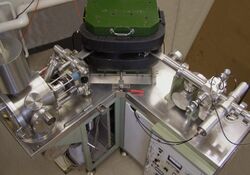Physics:Isotope fractionation

Isotope fractionation describes fractionation processes that affect the relative abundance of isotopes, phenomena which are taken advantage of in isotope geochemistry and other fields. Normally, the focus is on stable isotopes of the same element. Isotopic fractionation can be measured by isotope analysis, using isotope-ratio mass spectrometry or cavity ring-down spectroscopy to measure ratios of isotopes, an important tool to understand geochemical and biological systems. For example, biochemical processes cause changes in ratios of stable carbon isotopes incorporated into biomass.
Definition
Stable isotopes partitioning between two substances A and B can be expressed by the use of the isotopic fractionation factor (alpha):
- αA-B = RA/RB
where R is the ratio of the heavy to light isotope (e.g., 2H/1H or 18O/16O). Values for alpha tend to be very close to 1.[1][2]
Types
There are four types of isotope fractionation (of which the first two are normally most important): equilibrium fractionation, kinetic fractionation, mass-independent fractionation (or non-mass-dependent fractionation), and transient kinetic isotope fractionation.
Example
Isotope fractionation occurs during a phase transition, when the ratio of light to heavy isotopes in the involved molecules changes. When water vapor condenses (an equilibrium fractionation), the heavier water isotopes (18O and 2H) become enriched in the liquid phase while the lighter isotopes (16O and 1H) tend toward the vapor phase.[1]
See also
References
- ↑ 1.0 1.1 "Fundamentals of Stable Isotope Geochemistry". USGS. 2004. http://wwwrcamnl.wr.usgs.gov/isoig/res/funda.html.
- ↑ McGlynn, Shawn E.; "Biological Isotope Fractionation and Earth History: From Enzymes to Cells to Ecosystems" pp 59-79 in "Metals, Microbes and Minerals: The Biogeochemical Side of Life" (2021) pp xiv + 341. Walter de Gruyter, Berlin. Editors Kroneck, Peter M.H. and Sosa Torres, Martha. DOI 10.1515/9783110589771-003
Literature
- Faure G., Mensing T.M. (2004), Isotopes: Principles and Applications (John Wiley & Sons ).
- Hoefs J., 2004. Stable Isotope Geochemistry (Springer Verlag).
- Sharp Z., 2006. Principles of Stable Isotope Geochemistry (Prentice Hall).
 |

